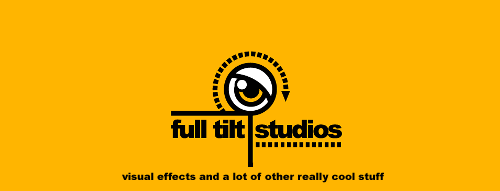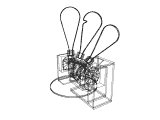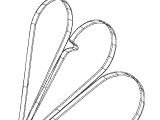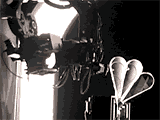

|
click image to view a sample movie |
Full Tilt Studios has a proprietary system of translating computer generated scenes, models, and camera motion into motion control camera information. The advantage of this system is it allows client and director alike to previsualize camera motion in detail, while simultaneously programming motion control camera moves. It reveals potential problems and gives all involved a clear understanding of what the finished piece should look like. It also saves money, because moves can be planned and debugged ahead of time, potentially saving thousands of dollars in stage time.
In 1999, NBC's Magic Room hired director Dan Schmidt to shoot a series of elements they could use throughout the year in their various network promotions. The elements, a set water jet carved glass peacock feathers, were to be mounted into a custom-designed rotating rig and table. The rig provided three axes of rotation for the feathers. The second part was a Lynx motion control system, which provided its own set of axes. The Lynx was positioned to augment the axes of the feather rig with its own axes. The net effect was a complex set of rotations and timing. When NBC returned in 2000 for another set of elements, director Schmidt was looking for a better way. Full Tilt Studios worked with Director of Photography David Kuklish first to build and program a CG scale model of the feather rig in Softimage 3D, a high end animation application. The model functioned exactly like its real life counterpart utilizing a series of positional and rotational constraints. They next built a virtual Lynx which would be constrained in 3D space to the motions available to its real life twin. Lens information was programmed into a virtual camera and they were set to go. This system allowed NBC creative directors to quickly create exactly the shots they wanted. Once programmed into Softimage 3D, the motion data was extracted and prepared for Kuper motion control input. A total of nine channels of motion were culled from Softimage 3D and piped into the Kuper. The remaining channels were used for zoom and focus. On set, a workstation was set up specifically to design additional shots and quickly send them to the Kuper. Now with an understanding of what NBC was looking for, Full Tilt Studios was able to easily design additional shots right there on set. Each pass was filmed at three to five frames per second, and there were an average of four passes per shot. The finished elements were processed and sent to the Magic Room where they will be edited, composited, time-squeezed, time-stretched, color corrected, enhanced, and artistically modified on the Inferno throughout the year. You can see the results daily on NBC's network promos. |
|




